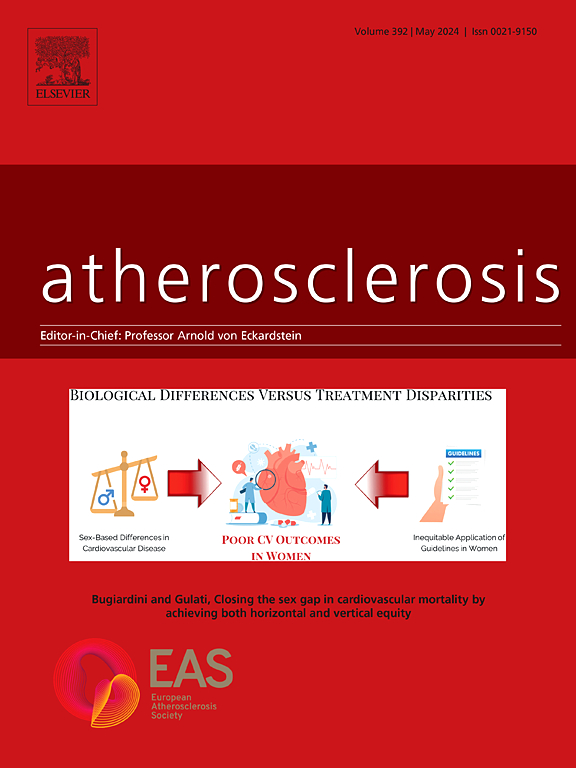Protein-truncating variants of the cholesteryl ester transfer protein gene and risk for coronary artery disease among patients with heterozygous familial hypercholesterolemia
IF 4.9
2区 医学
Q1 CARDIAC & CARDIOVASCULAR SYSTEMS
引用次数: 0
Abstract
Background
s: Cholesteryl ester transfer protein (CETP) inhibition has long been attracting a lot of attention if it could reduce the risk for coronary artery disease (CAD). A previous study has demonstrated that protein-truncating variants (PTVs) were associated with lower risk for CAD, which was dependent on lower LDL cholesterol in general population. We tested this hypothesis among Japanese heterozygous FH (HeFH) patients whose CAD risk was extremely high.
Methods
We investigated the clinical data of 2344 patients diagnosed with HeFH (mean age = 50 years, males = 1,174, median LDL cholesterol = 244 mg/dL) who were examined for their genotype of CETP and phenotypes, including the presence of CAD from 1990 to 2024 at Kanazawa University Hospital. We investigated whether PTVs of the CETP were associated with plasma lipid levels and CAD among patients with HeFH.
Results
We identified 42 patients (1.8 %) with a PTV of CETP in HeFH patients. Compared with non-carriers, carriers of a PTV of CETP had higher HDL cholesterol (effect size, 17.6 mg/dL; 95 % confidence interval [CI], 11.4 to 23.8; P < 0.001), lower LDL cholesterol (−15.4 mg/dL; 95 % CI, −24.5 to −6.3; P < 0.001), and lower lipoprotein (a) [Lp(a)] (−7.8 mg/dL; 95 % CI, −12.5 to −2.5; P < 0.001). CETP PTV carrier status was associated with reduced risk for CAD (odds ratio, 0.64; 95 % CI, 0.38 to 0.90; P < 0.001).
Conclusion
PTVs of CETP were significantly associated with higher HDL cholesterol, lower LDL cholesterol, lower Lp(a), and lower risk for CAD among patients with HeFH.

杂合子家族性高胆固醇血症患者胆固醇酯转移蛋白基因的蛋白质截断变异与冠状动脉疾病的风险
背景:抑制胆固醇酯转移蛋白(CETP)能否降低冠心病(CAD)的发病风险一直是人们关注的焦点。先前的一项研究表明,蛋白质截断变异(PTVs)与冠心病风险降低相关,这取决于一般人群中较低的LDL胆固醇。我们在CAD风险极高的日本杂合子FH (HeFH)患者中验证了这一假设。方法对金泽大学附属医院1990 - 2024年诊断为HeFH的2344例患者(平均年龄50岁,男性1174人,中位LDL胆固醇= 244 mg/dL)的临床资料进行CETP基因型和包括冠心病在内的表型检测。我们研究了HeFH患者中CETP的ptv是否与血脂水平和CAD相关。结果我们发现42例(1.8%)HeFH患者有CETP的PTV。与非携带者相比,CETP PTV携带者的高密度脂蛋白胆固醇较高(效应值为17.6 mg/dL;95%置信区间[CI], 11.4 ~ 23.8;P & lt;0.001),较低的LDL胆固醇(- 15.4 mg/dL;95% CI,−24.5 ~−6.3;P & lt;0.001),较低的脂蛋白(a) [Lp(a)](−7.8 mg/dL;95% CI,−12.5 ~−2.5;P & lt;0.001)。CETP PTV携带者状态与冠心病风险降低相关(优势比0.64;95% CI, 0.38 ~ 0.90;P & lt;0.001)。结论HeFH患者CETP的ptvs与较高的HDL胆固醇、较低的LDL胆固醇、较低的Lp(a)和较低的CAD风险显著相关。
本文章由计算机程序翻译,如有差异,请以英文原文为准。
求助全文
约1分钟内获得全文
求助全文
来源期刊

Atherosclerosis
医学-外周血管病
CiteScore
9.80
自引率
3.80%
发文量
1269
审稿时长
36 days
期刊介绍:
Atherosclerosis has an open access mirror journal Atherosclerosis: X, sharing the same aims and scope, editorial team, submission system and rigorous peer review.
Atherosclerosis brings together, from all sources, papers concerned with investigation on atherosclerosis, its risk factors and clinical manifestations. Atherosclerosis covers basic and translational, clinical and population research approaches to arterial and vascular biology and disease, as well as their risk factors including: disturbances of lipid and lipoprotein metabolism, diabetes and hypertension, thrombosis, and inflammation. The Editors are interested in original or review papers dealing with the pathogenesis, environmental, genetic and epigenetic basis, diagnosis or treatment of atherosclerosis and related diseases as well as their risk factors.
 求助内容:
求助内容: 应助结果提醒方式:
应助结果提醒方式:


